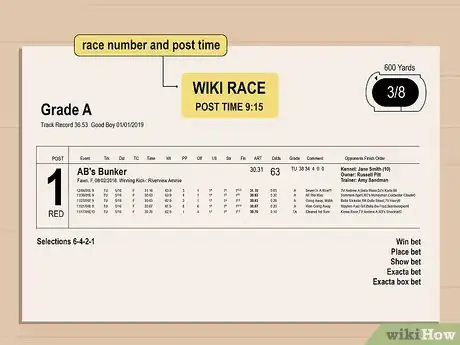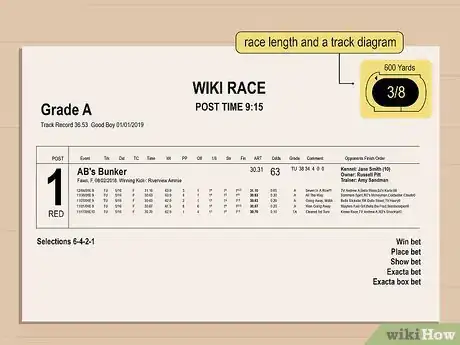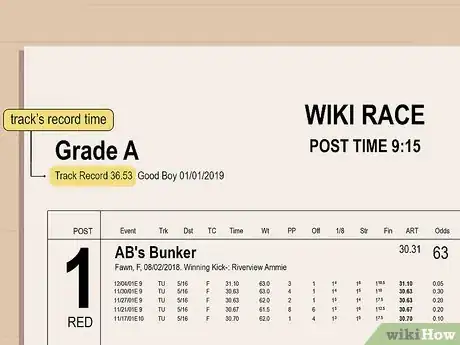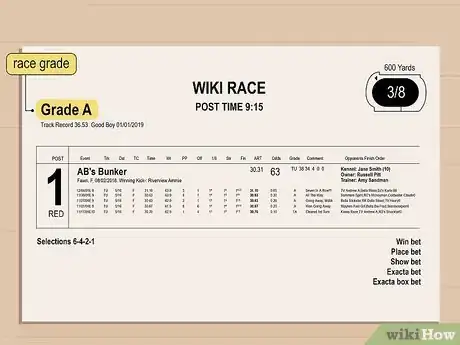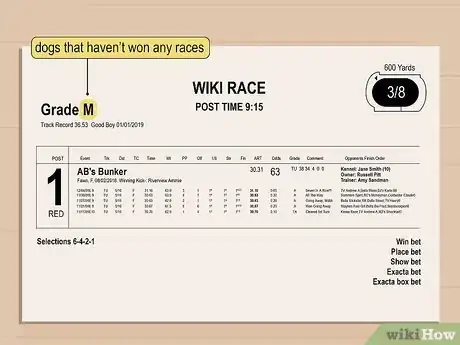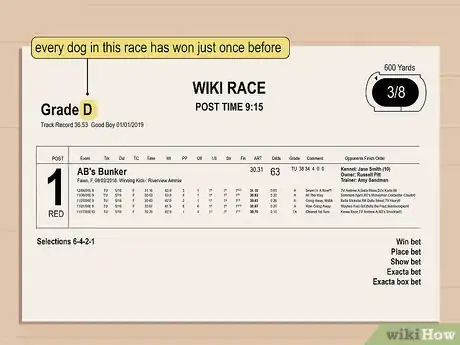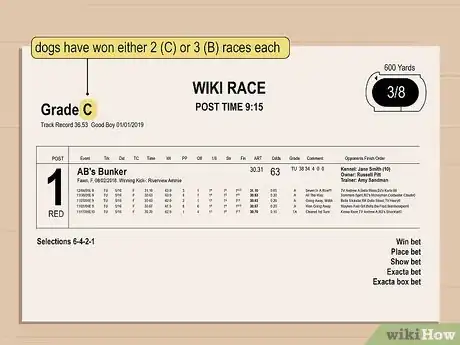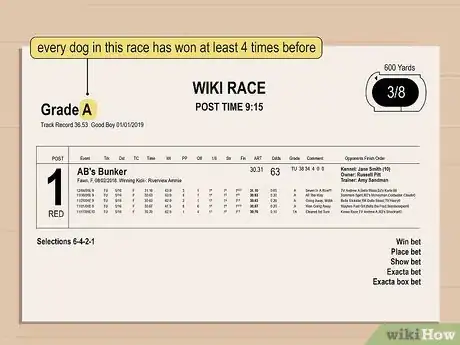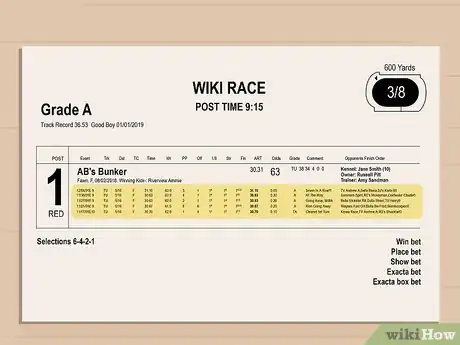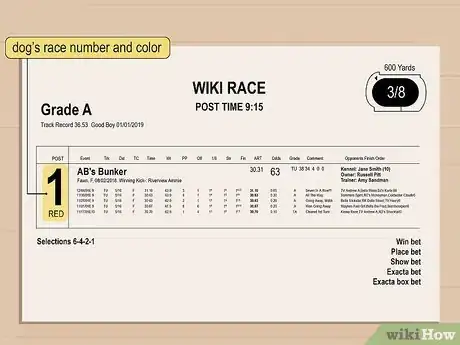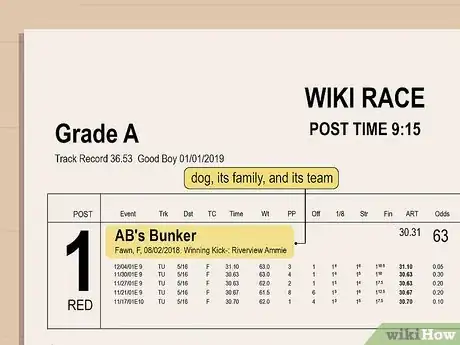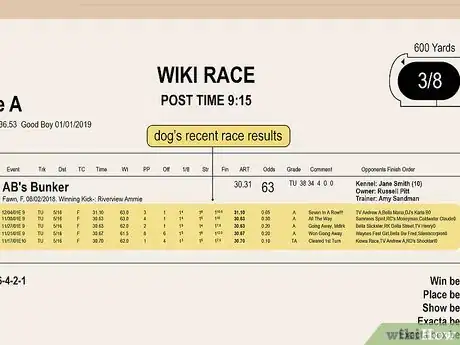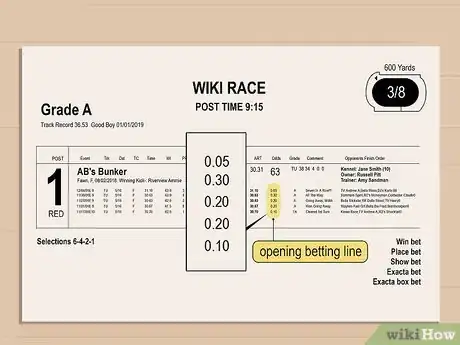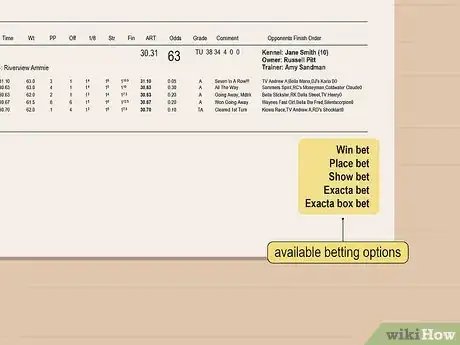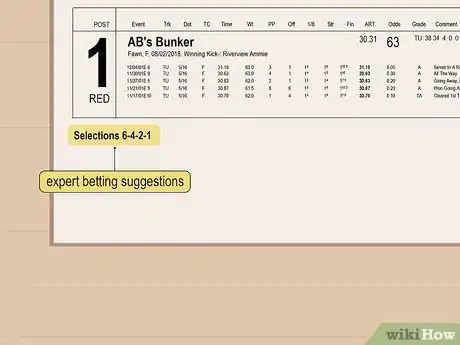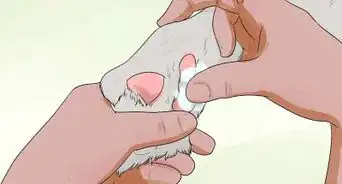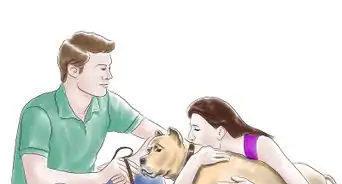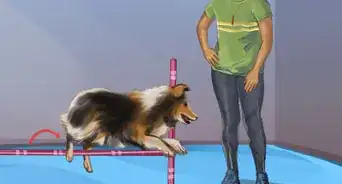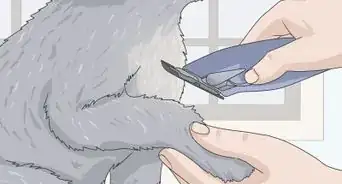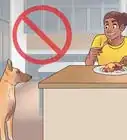This article was co-authored by wikiHow staff writer, Christopher M. Osborne, PhD. Christopher Osborne has been a wikiHow Content Creator since 2015. He is also a historian who holds a PhD from The University of Notre Dame and has taught at universities in and around Pittsburgh, PA. His scholarly publications and presentations focus on his research interests in early American history, but Chris also enjoys the challenges and rewards of writing wikiHow articles on a wide range of subjects.
This article has been viewed 12,241 times.
Learn more...
No day at the greyhound track is complete without a racing form to consult—especially if you plan to make some bets! Racing forms are jam-packed with numbers and abbreviations that can make your head spin at first, but they’re pretty easy to navigate once you pick up on the basics of the info provided. That said, keep in mind that there’s no universal standard for racing forms, so it’s important to use the abbreviation key and other instructions included with your form.
Steps
Finding Track and Race Info
-
1Look for the race number and post time at the top center. Greyhound tracks operate multiple races per racing session, and each race is given a number (1, 2, 3, etc.) based on its scheduled post time (starting time). Each individual race also gets its own racing form (racing sheet), which usually fits onto a single page. The race number and post time are nearly always listed at the top center of the sheet.[1]
- You’ll be very confused if you’re looking at the #2 (7:20 pm) racing form in anticipation of the #3 (7:40 pm) race!
- Busy tracks often have 10 races per session, and 2 sessions per day—afternoon and evening. Confirm the post time to ensure that you’re looking at the #4 evening session race and not the #4 afternoon session race.
- Post times are subject to change due to unforeseen delays, so keep alert to track announcements to confirm any schedule adjustments.
-
2Find the race length and a track diagram, often at the top right. Greyhound races are often in the range of 1,650–1,980 ft (500–600 m) in length, usually expressed (at least in the U.S.) either in yards (550, 660) or fractions of a mile (5/16, 3/8). As in horse racing, some greyhounds are better suited to either shorter or longer races, so the race length is an important detail to consider when choosing a favorite racer.
- Some racing forms also include a simple track diagram for the race. Greyhound races don’t always make an entire loop around the track, so the diagram lets you know the number and location of turns and straight sections.
- The race length and diagram (if provided) is usually placed at the top right of the form.
Advertisement -
3Check the top of the form for details like the track’s record time. The track record may seem like just a bit of trivia, but it can provide some useful insights. The record time can give you an idea whether it’s a “fast” or “slow” track compared to similar tracks, while a record time that was set very recently may indicate that the track is getting “faster.” You can also compare the track record to the individual dogs’ average times in recent races under similar conditions.
- The track record is often listed somewhere on the top of the form and usually includes the time (in seconds), date, and dog’s name.
- Some forms might also include the track’s season record—the best time during the current racing season.
Identifying the Race Grade
-
1Find the single-letter race grade placed prominently at the top. Greyhound races are organized so that dogs with similar racing abilities—based primarily on their number of race wins—compete against each other. The race grade is always easy to find somewhere along the top of the form, and is denoted by a single letter—most commonly M, D, C, B, or A.[2]
- The race grade doesn’t necessarily impact the quality of the race—a low-grade “M” race can be just as entertaining as a high-grade “A” race! But, if you want to make sure you’re seeing the best dogs race, and especially if you’re planning to make wagers, it’s important to know the race grade.
- Note that the M, D, C, B, A grading system isn’t universal, but that it is the most commonly used grading system in greyhound racing.
-
2Root for dogs that have yet to win in an “M” grade race. The “M” here stands for “maiden,” and refers to dogs that haven’t won any races. These races are made up of dogs that are new to racing, along with some veterans that simply have never been able to cross the finish line first.[3]
- Some “M” grade races may also include dogs that have won races before, but that have finished “out of the money” (outside of the top 3) for 5, 10, or another number of consecutive races.
-
3Compare the single-race winners in a “D” grade matchup. Every dog in this race has won just once before, or has finished first only 1 time after finishing outside the top 3 for perhaps 5 or 10 straight races. This means it should be a race full of winners that are hungry for more![4]
-
4Watch the multi-race winners in “C” and “B” grade races. In these categories, the dogs have won either 2 (C) or 3 (B) races each. These mid-level races tend to be the ones that sort out the truly exceptional winners from the “flash in the pan” racers that managed to win a couple of times.[5]
-
5Check out the best of the best in an “A” grade race. Every dog in this race has won at least 4 times before, which is no easy feat in greyhound racing. Expect to see the fastest times, the most skillful racers, and the most amount of fan interest (and wagering) here.[6]
- There may only be 1 “A” level race in a 10-race session. If so, it’ll probably be the last race of the session.
Getting Details on Each Greyhound
-
1Don’t be intimidated by the rows of densely-packed letters and numbers. Your first glance at the (literally) fine print that makes up much of the racing form may give you pause about actually using the guide. But give it a chance! With the help of the guide’s abbreviation key, which should either be on the sheet or provided along with it, you’ll quickly get the hang of deciphering the given details.[7]
- If you’re a novice at the greyhound races, ask a track worker or a racing enthusiast for some guidance on reading the sheet. If you’re interested, you may even get a few betting tips!
-
2Find each dog’s race number and color along the form’s left side. On most racing forms, large block numbers run down the left side, often from 1-8 or 1-10. Each number corresponds to the number given to an individual dog in that race. All the small print to the right of that number is info about that particular greyhound.[8]
- The race number may also be color coded, or you might see a color notation (like “red” or “green”) next to the race number. This refers to the color of the dog’s “jacket” for the upcoming race. You may hear people refer to dogs in the race by their racing number and/or jacket color—for instance, “the number 5 dog” or “the green racer.”
-
3Look for info on the dog, its family, and its team in larger print. This info is usually placed to the right of the dog’s race number along with a lot of other material, but in larger print than the rest. Each bit of information can help you decide which dog to root for. Check for data like the following:
- The dog’s name, such as “Sir Speedy” or “Grey Flash.”
- The dog’s age. The typical “racing age” span for a greyhound is between 2 and 5 years of age.
- The dog’s weight, which is usually around 65–70 lb (29–32 kg).
- The names of the dog’s parents. You might search online or ask around the track to see if either parent was a successful racer.
- Info on the dog’s owner, kennel, and/or trainer. Here again, you might want to search online or ask around the track.
-
4Read the fine print to decipher each dog’s recent race results. The rows and columns of tiny print to the right of the dog’s racing number give details about the greyhound’s last 5 or 6 races. Compare info about track conditions and each dogs’ recent performances to help choose your favorites for the current race. Common info includes:[9]
- The race’s date, time, track name (usually a 2-letter code like “AP”), race length, race grade, and track conditions (“F” for fast, “M” for muddy, etc.).
- The dog’s race weight, race number, and starting position (numbered 1-8 in most cases).
- The dog’s position at several marking points along the way during the race (“1” if the dog was in 1st place, and so on).
- The dog’s finishing time (“ART” for “actual running time”) and the winning time for the race (e.g., “31.12” [seconds]).
- The dog’s betting odds for the race.
- The names of the 1st, 2nd, and 3rd place finishers.
- Brief notes (less than a sentence) on the dog’s race performance (for example, “pulled away at end”).
Checking the Betting Info
-
1Identify the opening betting line for each dog in the race. You don’t have to wager in order to enjoy greyhound racing, but the racing forms are definitely created with bettors in mind. You’ll find betting odds for each dog in every race, but keep in mind that these are opening lines—the odds may be a bit different when you go to the betting window.[10]
- The odds may be shown as a pair of numbers separated by a hyphen, such as “9-2.” In this example, the odds tell you that you’ll earn $9 profit for each $2 you wager.
- The odds may instead be shown as a dollar amount—for instance, “$2.80.” In this example, the odds tell you that a $1 bet earns $2.80 in profit. (Keep in mind that the minimum bet at most tracks is $2, though.)
-
2Read over the available betting options at the bottom of the sheet. All greyhound forms list the permitted betting types somewhere, most often at the bottom center of the sheet. Common options include:[11]
- Win bet (straight bet): you win if your chosen dog wins. You get the dog’s listed odds (such as 9-2) for this bet.
- Place bet: you win if your chosen dog finishes 1st or 2nd. Reduced odds (potential winnings) compared to a win bet.
- Show bet: you win if your dog finishes 1st, 2nd, or 3rd. Reduced odds compared to a place bet.
- Exacta bet (perfecta bet): you win if you choose the correct 1st place and 2nd place finishers in the correct order. Increased odds compared to a win bet.
- Exacta (perfecta) box bet: you win if you choose the correct 1st place and 2nd place finishers in any order. This is technically 2 separate bets that essentially operate as 1 bet. Decreased odds compared to an exacta bet.
- Quinella bet: this is very similar to an exacta box bet, except that it’s a single bet instead of 2 separate (but linked) bets. The odds are also very similar to an exacta box bet.
- Trifecta/superfecta bets and box bets follow the same principles as exacta and exacta box bets, but require you to correctly pick the top 3 (trifecta) or top 4 (superfecta) race finishers. The odds and potential winnings continue to go up.
-
3Look for expert betting suggestions at the bottom of the form. Some forms include betting advice from an on-track handicapper to help guide your wagering choices. Check the bottom left or bottom right of the form for this advice. Of course, you’re free to ignore it and follow your own betting instincts![12]
- The advice might read like the following: “Selections 6-4-2-1.” This means the track expert expects the #6 greyhound to finish 1st, #4 to finish 2nd, and so on.
-
4Read over the betting disclaimers and reminders before wagering. You don’t want to miss out on a winning bet due to a technicality! The most common and important disclaimer is to check your betting slip before leaving the betting window—in other words, you aren’t allowed to rectify an error on the slip after you leave the window.[13]
- For example, if you pick the #2 greyhound to win and the window operator accidentally puts “#3” on your slip, you cannot get this error fixed once you leave the window. You’ll just have to root for the #3 dog instead!
Expert Q&A
-
QuestionSince a greyhound is a racing dog and sighthound, can I own one if I have an apartment?
 Mark GarciaMark Garcia is a Certified Dog Training Specialist and the Founder of Rosewood K9 based in Los Angeles, California. Mark specializes in dog training, boarding, and day care services. He uses scientifically proven methods for dog training that includes behavior and obedience training, confidence building, structured leadership, and positive puppy training.
Mark GarciaMark Garcia is a Certified Dog Training Specialist and the Founder of Rosewood K9 based in Los Angeles, California. Mark specializes in dog training, boarding, and day care services. He uses scientifically proven methods for dog training that includes behavior and obedience training, confidence building, structured leadership, and positive puppy training.
Certified Dog Trainer You should probably own a yard if you're considering getting a greyhound. While they're sweet and reserved, greyhounds are used to zooming around and catching prey. They'd thrive if they're provided a nice, open space where they can run and stay active.
You should probably own a yard if you're considering getting a greyhound. While they're sweet and reserved, greyhounds are used to zooming around and catching prey. They'd thrive if they're provided a nice, open space where they can run and stay active.
Warnings
- Not everyone believes that greyhound racing is an appropriate activity for the dogs. Some claim that the greyhounds are mistreated during their racing careers, and even more so after their careers are over.⧼thumbs_response⧽
References
- ↑ https://youtu.be/1nIjYxFvvV4?t=80
- ↑ https://youtu.be/1nIjYxFvvV4?t=30
- ↑ https://youtu.be/1nIjYxFvvV4?t=30
- ↑ https://youtu.be/1nIjYxFvvV4?t=30
- ↑ https://youtu.be/1nIjYxFvvV4?t=30
- ↑ https://youtu.be/1nIjYxFvvV4?t=30
- ↑ http://www.greyhoundswa.com.au/wp-content/uploads/sites/157/2014/10/Howtoreadasof20151127.pdf
- ↑ http://www.greyhoundswa.com.au/wp-content/uploads/sites/157/2014/10/Howtoreadasof20151127.pdf
- ↑ https://youtu.be/1nIjYxFvvV4?t=150
